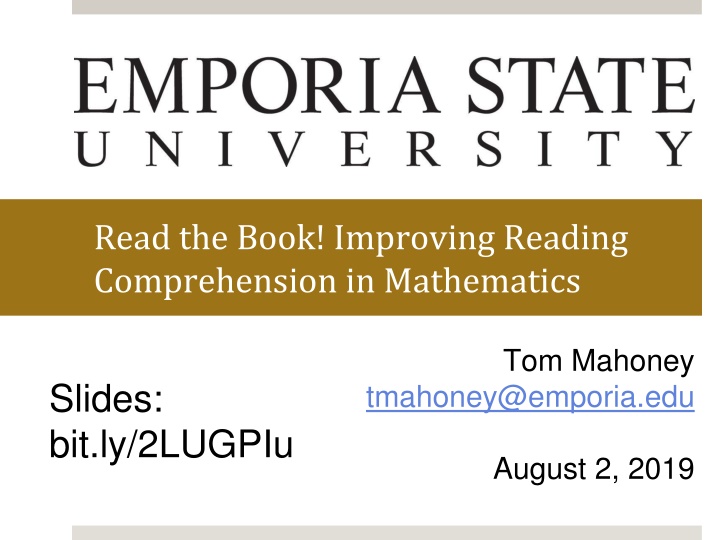
Enhancing Mathematics Reading Comprehension Through Proof Breakdowns
Explore the implementation of proof breakdowns in mathematics education to improve reading comprehension. Techniques such as peer review and structural analysis enhance student learning in online proof-writing courses. Discover the evolution, benefits, and challenges of this innovative approach.
Uploaded on | 1 Views
Download Presentation

Please find below an Image/Link to download the presentation.
The content on the website is provided AS IS for your information and personal use only. It may not be sold, licensed, or shared on other websites without obtaining consent from the author. If you encounter any issues during the download, it is possible that the publisher has removed the file from their server.
You are allowed to download the files provided on this website for personal or commercial use, subject to the condition that they are used lawfully. All files are the property of their respective owners.
The content on the website is provided AS IS for your information and personal use only. It may not be sold, licensed, or shared on other websites without obtaining consent from the author.
E N D
Presentation Transcript
Read the Book! Improving Reading Comprehension in Mathematics Tom Mahoney Slides: bit.ly/2LUGPIu tmahoney@emporia.edu August 2, 2019
Background When did I learn to read math? Goal: Avoid having my students make the same mistake Setting: Online graduate proof-writing courses Intro to Proofs, Advanced Calculus I, Graph Theory
Proof Breakdowns Give students a textbook proof to annotate Counts as part of weekly homework grade Provided Overleaf template and the commands \newcommand{\comment}[1]{{\color{red}{#1}}} \newcommand{\question}[1]{{\color{blue}{#1}}} Identify structural components: hypothesis, conclusion, proof technique used Differentiate definitions from results Connect consecutive statements
Adding Peer Review Expose students to other ways of reading a proof Opportunity to ask for clarification Used in MA757 Graph Theory (2017-2019) "Your breakdown of the second part helped me to understand it (I had had some trouble with it initially.)
Breakdown Evolution First attempt: Randomly assign each student a partner and complete a joint breakdown Unpopular because it presented scheduling challenges Switched to peer review instead of group submission for 2018 For 2019, requiring at least one \question{} to give more direction to the peer review Grading is based mostly on completion
Breakdowns: Pros and Cons Pros: Highlights proof structure Reinforces the need to read between the lines Peer review reveals multiple approaches Easy to implement and grade Cons: LaTeX could be a hurdle Hard to assign partial credit Logistics of peer review
Perusall: Collaborative Reading Free collaborative annotation tool Integrates with LMS (we use Canvas) Students access text through Perusall to annotate collaboratively Perusall identifies comments as Poor, Adequate, or Good Turns participation into a grade (lots of options!) Spring 2019, Adv. Calc. I: Lebl s free Introduction to Real Analysis 1-2 Assignments per week Earn full point for one Adequate or Good comment
Features Marking comments as questions @ Replies LaTeX integration
Results Averaged 2.37 posts per student per assignment: 3/student for first 12 assignments 1.76/student for last 12 assignments Found 20+ errata in the textbook Informed what to emphasis in lecture Lecture corrections or follow-up
Thank you! Slides: bit.ly/2LUGPIu Tom Mahoney tmahoney@emporia.edu
